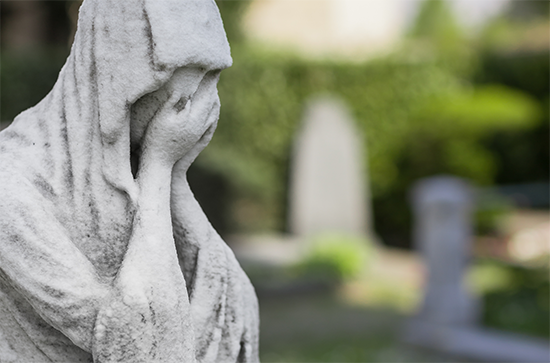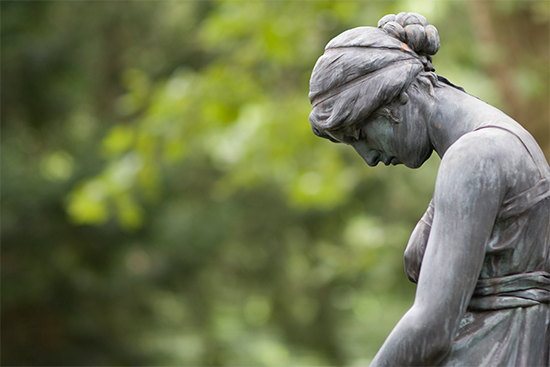
August-September 2016
Relentless Parenting
------------------
|






Seeing Through the Tears
By David Outlaw
A fetish priest carries a chicken to a crossroads in West Africa. He begins the funeral ritual for a recently deceased villager by killing the chicken and observing how it falls. From the chicken’s death, the priest divines the will of the spirits and reports back to the family in the village.
In Kazakhstan, a group of men scramble to the local cemetery to dig a grave hastily. Once the grave is dug and the body wrapped in a white cloth, the Imam presides over their friend’s funeral—all within 24 hours of his death. Later, they shave the mane and tail of the deceased’s favorite horse. At a memorial service a year later, they will slaughter the horse.
In India, a family builds a pyre on which to burn the remains of their loved one. Before burning the body, the tear-streaked family carries the corpse to be dipped one last time into the “sacred” water of the Ganges River. Once the body is ready, the nearest male relative lights the fire. According to the Hindu belief system, his spirit will continue the cycle of reincarnation, returning in another form based on the merit of his life.
In a South American jungle, a dead body lies in a hammock, tied between two trees. Another soul has been set free and, as the birds take what they want, the body is recycled into the world in a symbiotic relationship between all living things.
In Europe, a secularist mindset has eclipsed the message of former traditions. Any remaining rituals are from a paid Roman Catholic priest who mutters empty words. Though living with passion and fire, the years of pain seem to leave them in a state of emotional frigidity.

Wherever you travel, people die. While death is a constant throughout the world, funeral rituals are as unique as the cultures in which the people live. No time is more pregnant with symbolism than death. Death rites vary with regard to timing, viewing, conduct, and dress, but all these symbols reflect the worldview of the people who inhabit that culture. As the shadow of death darkens the lives of friends and family, the gospel can shine light into their lives. Our understanding of these rituals and the worldviews they reflect may provide openings for us to share the gospel.
Most cultures tend to explain life in the form of a story or narrative. They see creation, evil, ethics, and death through a grand story or “metanarrative.” Funeral rites reflect a community’s metanarrative in at least five areas.
-
Their view of the spirit world. Some cultures see death as a result of spiritual conflict and take measures to appease the spirits so they will not take further action against family or community. In animistic cultures, many small details accompany their funerals that seem harmless at face value. Sometimes the corpse is dressed or posed to fool the spirits. Widows may be responsible for dressing or acting in a prescribed manner to fool or satisfy the spirits. If you ask friends to explain why such a thing is practiced, you will likely receive a shrug. Often, however, if you ask, “What would happen if these things were not done?” you will see how deeply the people of that culture fear the spirits and how they seek to appease them.
-
The person’s worth. Western cultures, where the individual is revered, often embalm the body, preserving the physical shell of the person as long as possible. Cultures that see the individual as blending into some greater community tend to cremate the body.
-
The afterlife. As an extreme example, in ancient Egypt the people sent the Pharaoh into the next life with food, wealth, and even servants. Cultures often see the next life merely as an extension of the present life. I once performed a funeral for a man who loved motorcycles and the biker friends who came with it. I preached my heart out regarding God’s grace and love with little reaction from the crowd. Later in the service, a fellow biker played Lynyrd Skynyrd’s “Simple Man,” and there wasn’t a dry eye in the house. They viewed the service as ushering their friend to the great motorcycle ride in the sky. Different versions of this play out all over the world.
-
The expression of grief over the deceased. Often, these expressions link to the way the community considers the afterlife and the person’s role in it. Throughout history, some cultures have even hired mourners as a feature of the death ritual, providing a community announcement of the death as well as an expression of sadness at the loss of the departed.
-
The person’s relation to other ancestors in the afterlife. Elaborate stories attempt to explain the continued activity of the ancestors throughout the generations. In Muslim areas, Christian missionaries have faced this aspect of worldview in ways that have taken westerners by surprise. Muslim background believers have expressed their desire to “die as a Muslim,” because only then would they be allowed burial in the same cemetery where other members of their family have been buried. Other people may hear the gospel and believe its claims, but they face the fact that their ancestors did not turn to salvation. Realization of the exclusivity of the gospel may frighten them in terms of their ancestors. In other words, if this gospel is true, their ancestors are in eternal punishment. Missionaries from the highly individualistic west have difficulty understanding the significance of this barrier to those from cultures that highly value an intergenerational identity.
Understanding a non-Christian worldview in no way changes the truth of the gospel. A misunderstanding of reality because of an inaccurate “story” through which one sees life does not alter the fact this person will stand before God in judgment. This understanding does, however, give us some ideas about the barriers we encounter as we share the gospel with them. We have the opportunity to consider how to smooth the barriers as we build relationships with the people.
Death is not isolated to non-Christian people. One testimony for the gospel is the way God’s people mourn the loss of those we love. As Christians see death intrude into our lives, we must share the story of the creation, fall, and redemption in authentic ways that engage deep sorrow but reach for the explosive hope of life found in Christ. Let us weep, but not like those who have no hope. Our eyes flow with tears while our hearts pound with the hope of eternal life, resurrection, and the second coming.
Death lays bare the human heart. In its grip, we discover the strengths and weaknesses of our view of life. Funeral rituals provide valuable insight into the stories that sustain people. As we understand those stories, we become better equipped to introduce people to the true story of God’s redemption that provides strength in life and hope in death.
About the Writer: David is husband of Angie and father of five children ranging from 11 to 20 years old. He holds a Ph.D. in theology from Mid-America Baptist Theological Seminary and works for IM, training pastors and church leaders in Kazakhstan, Tajikistan, Russia, Cuba, Panama, and South Korea.
|
|

